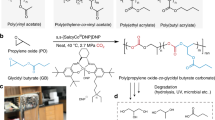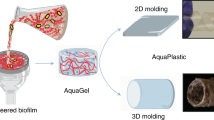Abstract
Enzyme-containing polymeric materials have been developed that have high activity and stability in both aqueous and organic media. These biocatalytic plastics, containing α-chymotrypsin and subtilisin Carlsberg, can contain up to 50% (w/w) total protein in plastic materials such as poly(methyl methacrylate, styrane, vinyl acetate, and ethyl vinyl ether). The activation achieved in organic solvents by incorporating proteases in plastic matrices allows for the efficient synthesis of peptides, and sugar and nucleoside esters. The marriage of enzyme technology with polymer chemistry opens up an array of unique applications for plastic enzymes, including active and stable biocatalysts in paints, coatings, resins, foams, and beads, as well as membranes, fibers, and tubings.
This is a preview of subscription content, access via your institution
Access options
Subscribe to this journal
Receive 12 print issues and online access
$209.00 per year
only $17.42 per issue
Buy this article
- Purchase on Springer Link
- Instant access to full article PDF
Prices may be subject to local taxes which are calculated during checkout
Similar content being viewed by others
References
Blanch, H.W. and Clark, D.S. 1995. Biochemical Engineering. Marcel Dekker, New York, NY.
Wiseman, A. 1985. Handbook of Enzyme Biotechnology, 2nd ed., Ellis Harwood, Ltd., New York, NY.
Clark, D.S. 1994. Prospects for exploiting immobilization to modify enzyme activity. Trends. Biotechnol. 12: 439.
Martinek, K., Klibanov, A.M., Goldmacher, V.S. and Berezin, I.V. 1977. The principles of enzyme stabilization I. Increase in thermostability of enzymes covalently bound to a complementary surface of a polymer support in a multipoint fashion. Biochim. Biophys. Acta 485: 1–12.
Dordick, J.S. 1989. Enzymatic catalysis in monophasic organic solvents. Enzyme Microb. Technol. 11: 194–211.
Takahashi, K., Ajima, A., Yoshimoto, T., Okada, M., Matsushima, A., Tamaura, Y. and Inada, Y. 1985. Chemical reactions by polyethylene glycol modified enzymes in chlorinated hydrocarbons. J. Org. Chem. 50: 3414–3415.
Pina, C., Clark, D.S. and Blanch, H.W. 1989. The activity of PEG-modified chymotrypsin in aqueous and organic media. Biotechnol. Blotechniq. 3: 333–338.
Yang, Z., Mesiano, A.J., Venkatasubramanian, S., Gross, S.H., Harris, J.M. and Russell, A.J. 1995. Activity and stability of enzymes incorporated into acrylic polymers. J. Am. Chem. Soc. 117: 4843–4850.
Ito, Y., Fujii, H. and Imanishi, Y. 1993. Catalytic peptide synthesis by trypsin modified with polystyrene in chloroform. Biotechnol. Prog. 9: 128–130.
Ito, Y., Fujii, H. and Imanishi, Y. 1992. Enzyme hybridization with synthetic polymers for use in organic media. Makromol. Chem. Rapid Commun. 13: 315–319.
Paradkar, V.M. and Dordick, J.S. 1994. Aqueous-like activity of α-chymotrypsin dissolved in nearly anhydrous organic solvents. J. Am. Chem. Soc. 116: 5009–5010.
Paradkar, V.M. and Dordick, J.S. 1994. Extraction and solubilization of chymotrypsin into isooctane in the presence of low concentrations of aerosol OT in the absence of reversed micelles. Biotechnol. Bioeng. 43: 529–540.
Matsuura, J., Powers, M.E., Manning, M.C. and Shefter, E. 1993. Structure and stability of insulin dissolved in 1-octanol. J. Am. Chem. Soc. 115: 1261–1264.
Meyer, J.D., Matsuura, J.E., Kendrick, B.S., Evans, E.S., Evans, G.J. and Manning, M.C. 1995. Solution behavior of α-chymotrypsin dissolved in nonpolar organic solvents via hydrophobic ion-pairing. Biopolymers 35: 451–456.
Klibanov, A.M. 1990. Asymmetric transformations catalyzed by enzymes in organic solvent. Ace. Chem. Res. 23: 114–120.
Tramper, J., VermŸe, M.H., Beeftink, H.H. and von Stockar, U. (eds.). 1992. Biocatalysis in Non-cotiventional Media. Elsevier, Amsterdam, The Netherlands.
Odian, G. 1991. Principles of Polymerization. John Wiley & Sons, Inc. New York.
Gabel, D. 1974. Active site titration of immobilized chymotrypsin with a fluorogenic reagent. FEBS Letters 49: 280–281.
Allcock, H.R. and Lampe, F.W. 1990. Contemporary Polymer Chemistry. PrenticeHall, Inc., Englewood Cliffs, NJ.
Wangikar, P.P., Michels, P.C., Clark, D.S. and Dordick, J.S. 1997. Structure and function of subtilisin BPŃ solubilized in organic solvents. J. Am. Chem. Soc. 119: 70–76.
Stepanov, V.M. 1996. Proteinases as catalysts in peptide synthesis. Pure and Applied Chemistry 68: 1335–1339.
Rich, J.O., Bedell, B.A. and Dordick, J.S. 1995. Controlling enzyme-catalyzed regioselectivity in sugar ester synthesis. Biotechnol. Bioeng. 45: 426–434.
Moris, F. and Gotor, V. 1993. A useful and versatile procedure for the acylation of nucleosides through an enzymatic reaction. J. Org. Chem. 58: 653–660.
Rich, J.O. and Dordiok, J.S. 1996. Controlling regioselectivity in enzyme-catalyzed acylation of polyhydroxyl compounds. Ann. N.Y. Acad. Sci. 799: 226–230.
Fields, R. 1971. The measurement of amino groups in proteins and peptides. Biochem. J. 124: 581–590.
Orthgeiss, E. and Dobias, B. 1990. Colorimetric determination of anionic surfactants. Biotechnol. Bioeng. 40: 91–102.
Wangikar, P.P., Carmichael, D., Clark, D.S. and Dordick, J.S. 1995. Active site titration of serine protaases in organic solvents. Biotechnol. Bioeng. 50: 329–335.
Author information
Authors and Affiliations
Corresponding author
Rights and permissions
About this article
Cite this article
Wang, P., Sergeeva, M., Lim, L. et al. Biocatalytic plastics as active and stable materials for biotransformations. Nat Biotechnol 15, 789–793 (1997). https://doi.org/10.1038/nbt0897-789
Received:
Accepted:
Issue Date:
DOI: https://doi.org/10.1038/nbt0897-789
This article is cited by
-
Prominent Study on Surface Properties and Diffusion Coefficient of Urease-Conjugated Magnetite Nanoparticles
Applied Biochemistry and Biotechnology (2018)
-
Printable enzyme-embedded materials for methane to methanol conversion
Nature Communications (2016)
-
Impact of the configuration of a chiral, activating carrier on the enantioselectivity of entrapped lipase from Candida rugosa in cyclohexane
Biotechnology Letters (2014)
-
Stabilization of the Cellulase Enzyme Complex as Enzyme Nanoparticle
Applied Biochemistry and Biotechnology (2012)
-
The Use of PAMAM Dendrimers as a Platform for Laccase Immobilization: Kinetic Characterization of the Enzyme
Applied Biochemistry and Biotechnology (2012)



